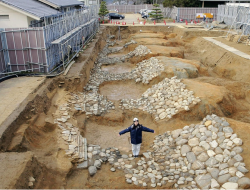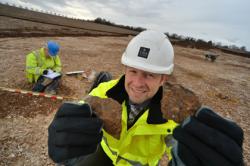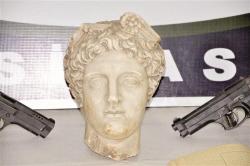INSTITUT SUPERIEUR D'ANTHROPOLOGIE
INSTITUTE OF ANTHROPOLOGY
ONLINE COURSES / COURS A DISTANCE
SPRING TERM : APRIL 2015
REGISTER NOW
JAPON –  Asuka - A huge stone-paved moat believed to be a part of a rectangular tumulus from the mid-seventh century was found in Asuka, Nara Prefecture, a prefectural institution has announced. The Archaeological Institute of Kashihara has concluded that it is probably part of the former grave of Emperor Jomei (629-641), who was later buried in a different location. Emperor Jomei was the father of Prince Nakano-Oe, later Emperor Tenji (668-671). The excavated moat stretches for 50 meters from east to west, and is believed to have been the biggest rectangular ancient tomb in the Asuka district at that time. It is thought to be larger than the Ishibutai rectangular tumulus, created in the early seventh century, where Soga no Umako (unknown-626) is believed to be buried. The size of the moat has been confirmed as 3.9 meters in width by 1 meter in depth. The bottom and the northern sloped side were paved with granite. Bars made of various types and colors of stones were piled like stairs on its northern sloped side, which can be seen at the foot of the mound. In Nihon Shoki (Chronicles of Japan), it is written that Emperor Jomei was initially buried in Namehazama no Oka hill, but later buried in Oshisaka Ryo’s grave — which is assumed to be the Dan no Zuka tumulus at Sakurai in the prefecture — in 643. The institution considers the newly found moat to be part of Namehazama no Oka.
Asuka - A huge stone-paved moat believed to be a part of a rectangular tumulus from the mid-seventh century was found in Asuka, Nara Prefecture, a prefectural institution has announced. The Archaeological Institute of Kashihara has concluded that it is probably part of the former grave of Emperor Jomei (629-641), who was later buried in a different location. Emperor Jomei was the father of Prince Nakano-Oe, later Emperor Tenji (668-671). The excavated moat stretches for 50 meters from east to west, and is believed to have been the biggest rectangular ancient tomb in the Asuka district at that time. It is thought to be larger than the Ishibutai rectangular tumulus, created in the early seventh century, where Soga no Umako (unknown-626) is believed to be buried. The size of the moat has been confirmed as 3.9 meters in width by 1 meter in depth. The bottom and the northern sloped side were paved with granite. Bars made of various types and colors of stones were piled like stairs on its northern sloped side, which can be seen at the foot of the mound. In Nihon Shoki (Chronicles of Japan), it is written that Emperor Jomei was initially buried in Namehazama no Oka hill, but later buried in Oshisaka Ryo’s grave — which is assumed to be the Dan no Zuka tumulus at Sakurai in the prefecture — in 643. The institution considers the newly found moat to be part of Namehazama no Oka.
http://the-japan-news.com/news/article/0001859547?
ROYAUME UNI –  Barton Farm - Months of excavations have begun at a former military base in Winchester where a farmstead, prehistoric trackway and burial grounds were discovered by archaeologists during an initial investigation which revealed a kitchen used by soldiers. Early evidence suggests that Barton Farm was a late-Prehistoric farm from between 500 BC and 250 AD. Trial digs found facilities used by hungry members of the Hessians – a group of German mercenaries who were employed by the British government and travelled to fight in North America during the Revolutionary War of the late 18th century.
Barton Farm - Months of excavations have begun at a former military base in Winchester where a farmstead, prehistoric trackway and burial grounds were discovered by archaeologists during an initial investigation which revealed a kitchen used by soldiers. Early evidence suggests that Barton Farm was a late-Prehistoric farm from between 500 BC and 250 AD. Trial digs found facilities used by hungry members of the Hessians – a group of German mercenaries who were employed by the British government and travelled to fight in North America during the Revolutionary War of the late 18th century.
http://www.culture24.org.uk/history-and-heritage/archaeology/art513478-archaeologists-find-soldiers-kitchen-and-prehistoric-remains-at-hampshire-farmstead
ROYAUME UNI –  York - What lies beneath Clifford's Tower? That's the question archaeologists hope to answer as part of an on-going investigation throughout this year looking at the historic tower and the mound on which it sits. They hope to be able to better understand its archaeology and its structural stability. The tower, which is almost all all that remains of York Castle, which was originally built by William the Conqueror, is closed for two weeks. On Tuesday a crane was used to lift borehole equipment into the tower as it was too large to go through the medieval doors. The story of Clifford's Tower has been colourful and sometimes violent, and over the centuries the tower's mound, set in the heart of Old York, has been rebuilt many times, sometimes changing radically. In 1826 the lower slopes were removed and the mound was then circled with a stone wall. Later in 1935 the missing lower slopes were reconstructed and the stone wall buried within the mound. Over the course of the 20th century little work was done to explore the physical make-up of the mound and its many archaeological layers.
York - What lies beneath Clifford's Tower? That's the question archaeologists hope to answer as part of an on-going investigation throughout this year looking at the historic tower and the mound on which it sits. They hope to be able to better understand its archaeology and its structural stability. The tower, which is almost all all that remains of York Castle, which was originally built by William the Conqueror, is closed for two weeks. On Tuesday a crane was used to lift borehole equipment into the tower as it was too large to go through the medieval doors. The story of Clifford's Tower has been colourful and sometimes violent, and over the centuries the tower's mound, set in the heart of Old York, has been rebuilt many times, sometimes changing radically. In 1826 the lower slopes were removed and the mound was then circled with a stone wall. Later in 1935 the missing lower slopes were reconstructed and the stone wall buried within the mound. Over the course of the 20th century little work was done to explore the physical make-up of the mound and its many archaeological layers.
http://www.yorkpress.co.uk/news/11726442.Archaeologists_digging_to_reveal_secrets_of_Clifford_s_Tower___s_mound/
ROYAUME UNI –  Caernarfon -A series of “unexpected” archaeological finds have emerged during construction work at Caernarfon Castle. Pistols, musket balls and a large stone piece of a canon ball were found by workers during the construction of new ticket booths at the castle, which date back to when the structure was used as a stronghold during the English Civil War in the 17th century. Iwan Parry, of the Gwynedd Archaeological Trust, said: “These lead pistols, balls for muskets and tobacco pipes and so on tell us there was increased activity within the castle walls around the time of the Civil War. “By then, the castle was in poor condition, but was held on behalf of the King by Lord Byron, and was kept under siege three times within its walls.” The castle was built in 1283 on the orders of King Edward I in his campaign to subdue the conquered Welsh people. Among the other unusual finds near the structure were a piece of Roman pottery, thought to be 1,000 years older than the castle and transported from Segontium to the castle when clay was needed during construction, as well as oyster shells and animal bones. Mr Parry said: “A pool of refuse that was found is likely to date from the period when the castle was being built. “It included a large amount of animal bones and shells, including oyster shells came, very similar to those found in the Straits. “Hopefully, by analyzing the findings further, we have further information on diet of the people who raised the castle.”
Caernarfon -A series of “unexpected” archaeological finds have emerged during construction work at Caernarfon Castle. Pistols, musket balls and a large stone piece of a canon ball were found by workers during the construction of new ticket booths at the castle, which date back to when the structure was used as a stronghold during the English Civil War in the 17th century. Iwan Parry, of the Gwynedd Archaeological Trust, said: “These lead pistols, balls for muskets and tobacco pipes and so on tell us there was increased activity within the castle walls around the time of the Civil War. “By then, the castle was in poor condition, but was held on behalf of the King by Lord Byron, and was kept under siege three times within its walls.” The castle was built in 1283 on the orders of King Edward I in his campaign to subdue the conquered Welsh people. Among the other unusual finds near the structure were a piece of Roman pottery, thought to be 1,000 years older than the castle and transported from Segontium to the castle when clay was needed during construction, as well as oyster shells and animal bones. Mr Parry said: “A pool of refuse that was found is likely to date from the period when the castle was being built. “It included a large amount of animal bones and shells, including oyster shells came, very similar to those found in the Straits. “Hopefully, by analyzing the findings further, we have further information on diet of the people who raised the castle.”
http://www.northwaleschronicle.co.uk/news/143087/series-of-unexpected-archaeological-finds-at-caernarfon-castle.aspx?
TURQUIE –  -Anatolie - A large number of historical artifacts, including the head of a 2,000-year-old Hermes statue, have been seized during an operation The police department simultaneously raided various addresses in villages and districts of the Central Anatolian province of Sivas, as well as in Nevşehir, Adıyaman and Kayseri on Jan. 13, and discovered historical artifacts.Along with the head of Hermes, three rings, a plate, 23 coins, six Ottoman-language books, a metal ashtray, two column pieces and four stones inscribed with various motifs were also among the findings during the operation.
-Anatolie - A large number of historical artifacts, including the head of a 2,000-year-old Hermes statue, have been seized during an operation The police department simultaneously raided various addresses in villages and districts of the Central Anatolian province of Sivas, as well as in Nevşehir, Adıyaman and Kayseri on Jan. 13, and discovered historical artifacts.Along with the head of Hermes, three rings, a plate, 23 coins, six Ottoman-language books, a metal ashtray, two column pieces and four stones inscribed with various motifs were also among the findings during the operation.
http://www.hurriyetdailynews.com/head-of-god-hermes-seized-in-anatolia.aspx?pageID=238&nID=77069&NewsCatID=375